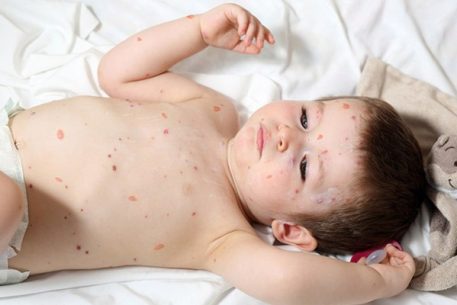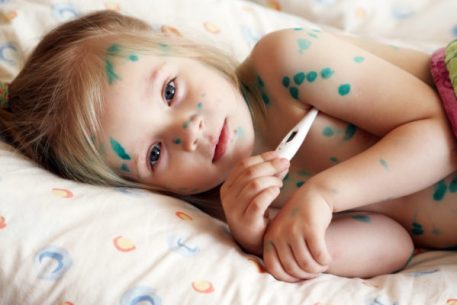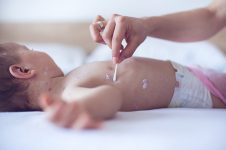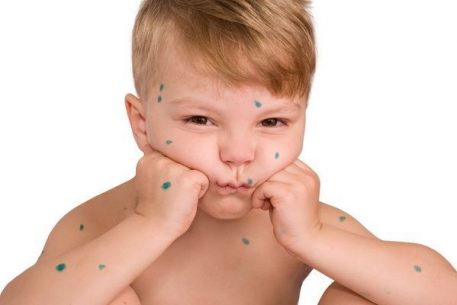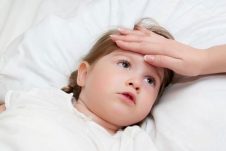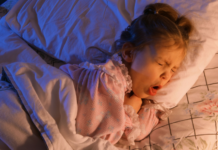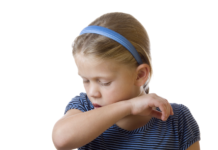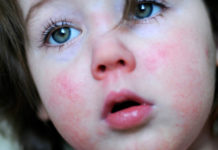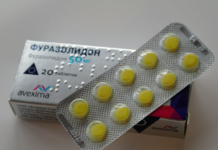Causes, typical signs, symptoms and treatment of chickenpox in children is an urgent problem for parents. Pediatricians say that the vast majority of young patients can easily tolerate chickenpox. Various complications more often occur in newborns, adolescents and adults with weakened immunity.
Material Content:
How does chickenpox begin in children
The acute phase of the disease occurs after the end of the incubation period. Often, chickenpox in children begins with subfebrile or mild fever (up to 38 ° C), dizziness, loss of appetite, diarrhea. The patient may also have headaches and muscle pains.
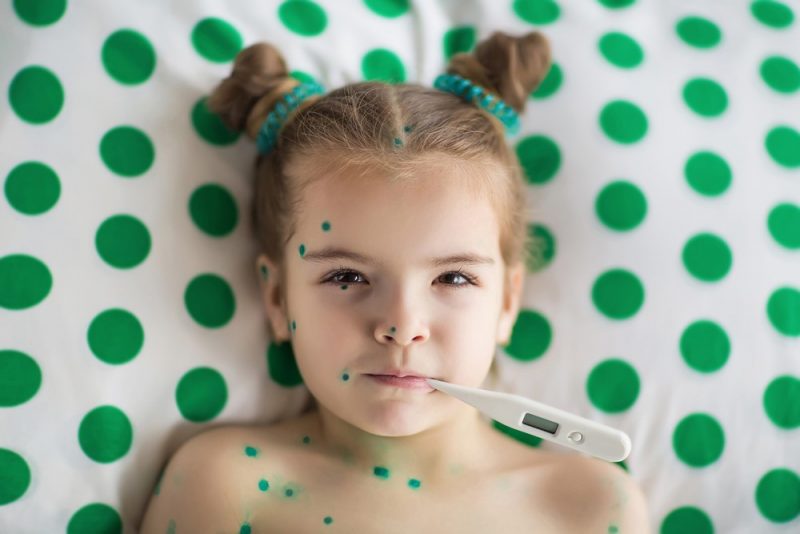
At the same time or several hours later than the peak of the fever, itching of the skin begins, local swelling and small red spots (macula) appear. Gradually, they turn into bubbles with a thin pink or red rim. Spots primarily occur on the head among the hair on the face.
Incubation period
The most common variant of varicella zoster chickenpox virus infection is direct contact of a healthy child with an infected patient. The causative agent is excreted by a sick body with saliva and sputum, stored in skin particles. The infection spreads by airborne droplets within the same apartment or house. Sometimes viral particles penetrate different floors of a building.
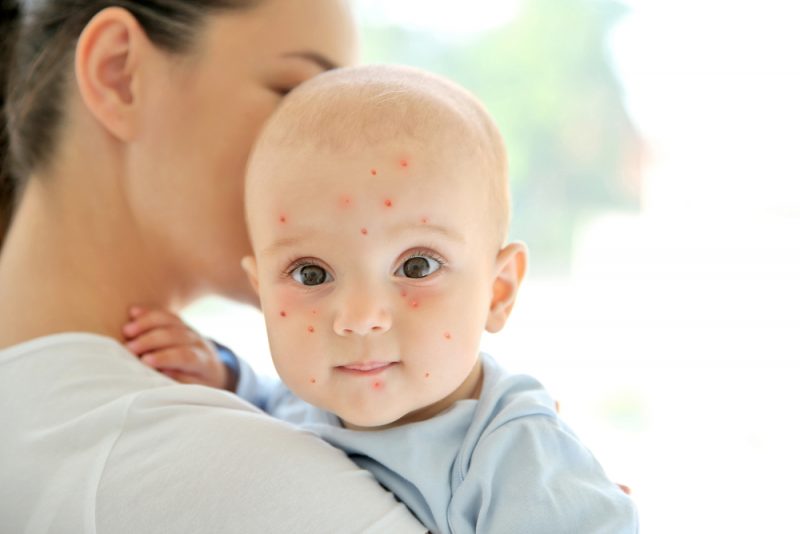
The causative agent of chickenpox enters the mucous membranes with air currents of a previously uninfected child or adult, and enters the bloodstream.The virus spreads in the body, but its presence is not manifested by symptoms. The duration of the incubation period for infection with Varicella Zoster varies from 7 to 21 days.
10-14 days after infection, the symptoms of a viral disease appear.
Each clinic keeps records of cases of chickenpox in institutions. The pediatrician takes into account the environment of a small patient with signs of chickenpox. Contacts with patients with chickenpox are important for proper diagnosis 8–21 days before visiting a doctor.
Symptoms and signs of the disease
Pediatricians pay attention to the presence of the first two signs of chickenpox in a child. The main criteria are an increase in temperature and the appearance of characteristic rashes. Itchy vesicles in almost all young children are localized on the head in the hair, on the face, stomach and legs. A characteristic feature is also the development of a vesicular rash in the acute period against a background of mild intoxication. Vomiting, diarrhea, severe headaches rarely appear in a patient with chickenpox baby.
Each element of the rash goes through 4 stages in a row:
- Macula is a small red spot.
- Papule is a nodular formation without a cavity inside.
- A vesicle is a bubble filled with transparent contents, slightly pressed in the center.
- Drying crust after a bursting bubble, falling off after 2 weeks.
In the midst of a disease in one area of the skin, all elements of the rash develop simultaneously. After the crusts dry, the itching disappears, the skin condition of the child normalizes. Rashes are rarely found in the groin, on the buttocks. The palms and soles are usually free of rash.
An asymptomatic course of chickenpox occurs, but is extremely rare. With a mild form of infection, the temperature remains normal or rises to 37.1–37.5 ° C. In these cases, less than 10 vesicles appear on the skin, less than 20 elements of a rash are formed.
When to see a doctor
If adult family members know what chickenpox looks like in children, they will not send a child with symptoms of a viral infection to a garden or school. The pediatrician needs to be called to the house. It happens that adults, not recognizing chickenpox by the first signs, go to the clinic with children.

A child with chickenpox is isolated until complete recovery. The quarantine period in the kindergarten group or class that patients attended was introduced for 3 weeks.
Call a doctor immediately if chickenpox symptoms appear in an infant or adolescent. These are patients at risk, who have a particularly severe viral infection, a higher risk of serious complications.
How many days does chickenpox last in a child
The duration of the disease depends on the state of the patient’s immune system. An increase in temperature, most often insignificant, is observed mainly in the first 1-2 days of illness. The rash develops simultaneously or during the following hours of illness. Itchy spots and nodules on the body appear in waves.

Recovery occurs 10-14 days after the onset of the disease.
The infectious period lasts from the last day of pathogen incubation for another 5 to 10 days. Infection is not transmitted to others if new elements of the rash do not form within 5 days. Only a doctor can decide when a small patient will be able to attend an institution.
After the final “wave” of rashes, all the bubbles on the body heal. For 3-5 days, the new elements of the rash are covered with dry falling crusts. After cleansing, the skin is fully restored in 2-3 weeks.
Treatment of chickenpox in children
The entire period from the appearance of the rash to the full recovery must be more thorough than usual to take care of the skin. A more accurate cleansing of the mucous membranes of the mouth, eyes and nose will be required. The child needs light food, mainly dairy and vegetable products, warm drink.
Drug therapy
The pediatrician determines the duration of treatment, taking into account the form, severity of the disease, the age of the patient and the presence of concomitant pathologies.Pediatricians prescribe compliance with the half-bed regimen all days when the child has a fever. A newborn, infant or teenager with chickenpox is hospitalized to prevent possible complications.
Antipyretic drugs
When the temperature rises above 38.5 ° C, the child is given paracetamol in the form of a syrup or rectal suppositories with the same active substance are administered. The interval between doses of this tool should be at least 4 hours. The duration of treatment with paracetamol is not more than 3 days. If the fever does not pass during this period, then the antipyretic medicine is changed.
In the absence of a therapeutic effect, ibuprofen is prescribed orally in the form of a syrup or tablets. The tool has a stronger antipyretic effect. In case of non-compliance with dosages or prolonged treatment, the patient's temperature drops below 35 ° C. Ibuprofen is not only an antipyretic, but also a powerful anti-inflammatory and analgesic.
Soluble tablets Ibuklin Junior - a combination of paracetamol with ibuprofen. The combined remedy is used for febrile syndrome in children older than 3 years.
Antihistamine
Fenistil is prescribed to eliminate itching at the site of the vesicles. Breast babies up to a year can be given 10 drops, children from one to 3 years old - 15 drops, children older than 3 years - 20 drops three times a day. The duration of treatment with an antihistamine is from 3 to 6 days.
Antiviral agents
Tablets Acyclovir or Vivorax, less often - Isoprinosine, are indicated for severe forms of chickenpox. Antiviral agents, as well as immunomodulators (Anaferon children, Ergoferon), it is better to take in the first hours and days of the disease, with the initial symptoms of acute infection.
Outdoor facilities
Bubbles on the skin are greased with brilliant green (1% solution of brilliant green). This is a dual-use agent: it disinfects the elements of the rash and serves as a “marker” for new vesicles. Castellani-colored liquid (Fukortsin), raspberry-colored, potassium permanganate (potassium permanganate solution) is used.
Antiseptics dry the vesicles, accelerate the flow of liquid and the formation of crusts, and prevent the development of bacterial superinfection.
To eliminate itching and pain in the area of the vesicles, ointment is applied. Use Fenistil in the form of a gel, Psilo-balm (contains the antiallergic substance diphenhydramine), Advantan. The third drug is a corticosteroid ointment (GCS), which has anti-inflammatory and soothing effects. Advantan is less dangerous for the skin of babies, compared with other corticosteroids, can be used for a long time without fear for the condition of the sensitive skin of the child.
Folk remedies
Walnut has many medicinal effects that are beneficial for chickenpox. Brew dry leaves like tea, insist 2 hours. Give the patient to drink a sip during the day. Tincture of green walnuts with honey strengthens weakened immunity. Chop the nuts, add an equal volume of honey, insist for a month. The child is given ½ tsp. funds three times a day before meals.

Bubbles in the oral cavity can be lubricated with sea buckthorn oil.
Bathtubs with baking soda, sea salt and herbs have calming and healing effects. Water procedures begin after normalizing the temperature, drying the elements of the rash. Baths in the early days of the disease are not recommended for the reason that a viral infection with fluid from the vesicles spreads to healthy areas of the skin.
Add to the water for bathing the baby an infusion of a string or celandine (natural antiseptics), a decoction of chamomile or oak bark (natural anti-inflammatory and soothing agents). Plant extracts reduce itching, prevent bacterial infection. An anti-inflammatory effect is exerted by baths with infusion of calendula, sage, and yarrow.
Take 200 g of one herb or pick for infusion or broth, heat in 5 l of water over low heat to a boil.Oak bark is boiled for about 15 minutes, flowers, leaves - from 3 to 5 minutes. The broth should be infused from 40 minutes to 2 hours, after which the solution is poured into the bath. If necessary, dilute with cold water to 36–37 ° C. The bath should not be hot.
Reduces pruritus soda solution. Add 100 g of sodium bicarbonate first in warm water, stir until completely dissolved. Then the liquid is added to the bath. Recommended duration of water procedures is from 10 to 15 minutes.
Possible complications and consequences
Atypical chickenpox is more common in children with weakened immunity, with exhaustion of the body. Rashes may appear on the eyelids, nasal mucosa and oral cavity, in the rectum. Acyclovir is prescribed to patients to reduce the activity of the virus in the body.
The most common complication of chickenpox is bacterial superinfection, suppuration of the vesicles. Less commonly, pneumonia and inflammation of the brain occur. With bacterial superinfection, a course of antibacterial therapy is prescribed. Complications are most dangerous in the chest and adolescent periods.
Varicella Zoster remains after the initial infection and illness in the body for life. Chickenpox in the same form as the first time does not occur.
The virus activates with a decrease in immunity in a person of any age who has already had chickenpox. Rashes appear in the form of groups of small bubbles in the upper abdomen and back. This is herpes zoster, caused by the same pathogen. The disease is accompanied by mild fever, severe pain, intolerable itching at the site of the vesicles.
Preventive measures
If a patient with chickenpox is immunocompromised, then using acyclovir and limiting contacts, it is possible to mitigate the manifestations of a viral infection. Vaccination is carried out only in a group of patients from 1 year to 12 years with immunosuppressed. Most children are not vaccinated against chickenpox.
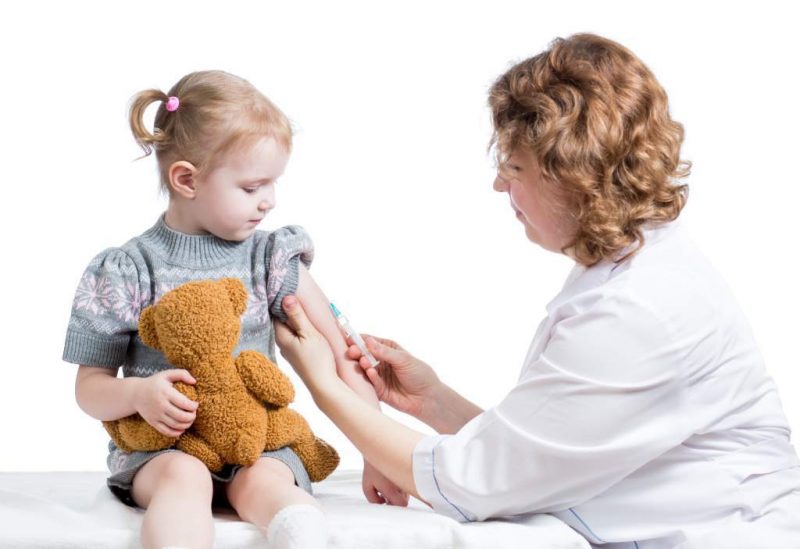
Other parents sigh with relief if the child has chickenpox at the age of 4–6, since there is no need to fear infection in the future.
Chicken pox affects children aged 2–3 to 10 years who have not previously been sick or vaccinated. The causative agent is transmitted from patients to healthy ones with droplets of sputum during coughing, as well as in contact with a bubble rash on the skin of an infected person.
Treatment in most cases is symptomatic. A sick child needs to ensure a calm environment, give an antipyretic for fever and an antihistamine. Bubbles should be treated with antiseptic solutions and ointments for itching. Antiviral treatment is effective in the first few days of illness until the viruses invade cells, where they become inaccessible to drugs.


